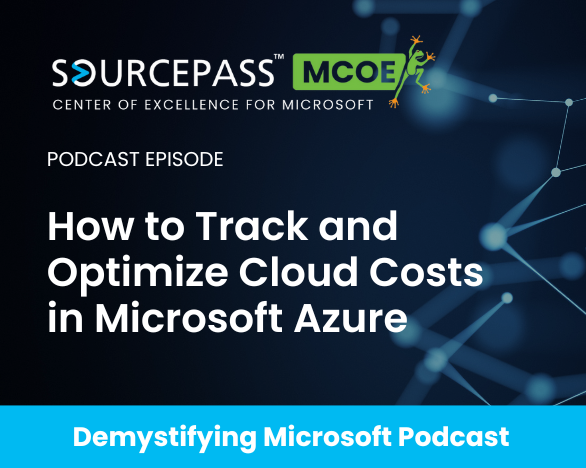6 min read
Microsoft Licensing Update: Windows 365 Cloud Apps Now in Preview
Microsoft’s Windows 365 Cloud Apps, now available in public preview, introduces a new way for organizations to deliver only the applications users...
3 min read
Nicole Walker
:
Jul 30, 2025 9:00:00 AM

Organizations using Microsoft Azure often face unpredictable cloud bills and wasted spend. The most effective way to reduce costs is to understand how Microsoft bills for Azure resources and to leverage every available discount and optimization feature.
Applying proven strategies such as optimizing virtual machine pricing, licensing structures, resource sizing, and security workload management can result in savings of 30% to 50% or more on overall Azure costs.
In this episode of Demystifying Microsoft podcast, Nathan Taylor (SVP, Global Microsoft Practice Leader at Sourcepass MCOE) explores the real-world levers for Azure cost management, including reservations, hybrid use benefits, VM sizing, SQL licensing, and Sentinel log retention. The discussion covers the use of the Azure Pricing Calculator, methods for identifying cost-saving opportunities, and common pitfalls that contribute to overspending.
Unexpected cloud expenses often result from a few recurring issues. Oversized virtual machines, missed opportunities for licensing discounts, and inefficient log retention practices are among the most frequent contributors to wasted spend. Failing to right-size resources, overlooking hybrid use benefit eligibility, or sending excessive data to security tools like Microsoft Sentinel can quickly inflate monthly bills. Addressing these pitfalls with targeted optimization techniques helps control costs and ensures that cloud investments deliver maximum value.
Reservations allow you to commit to specific VM sizes and regions for one or three years, unlocking discounts up to 72% for predictable workloads.
Hybrid use benefit lets you apply existing Windows Server or SQL Server licenses to Azure VMs, eliminating license fees and reducing costs by up to 40%. Combining these strategies can cut VM costs by more than half.
Oversized VMs are a major source of wasted spend. Use Azure Advisor and Cost Management tools to analyze usage and right-size resources. Schedule auto-shutdowns for non-production workloads and automate resizing for variable workloads. For Azure Virtual Desktop, turn off VMs after hours to avoid unnecessary charges.
SQL licensing costs in Azure scale with the number of cores assigned to each virtual machine. Matching resources to actual workload requirements and leveraging hybrid use benefit for eligible SQL workloads can significantly reduce licensing expenses.
For Microsoft Sentinel, controlling costs requires tuning log ingestion to focus on actionable data, selecting appropriate long-term retention tiers, and filtering out non-essential logs. Regular review of data retention policies and ingestion rates helps prevent unexpected billing spikes and keeps security operations cost-efficient.
Azure Cost Management is a suite of tools for monitoring, analyzing, and optimizing cloud spending in Microsoft Azure. It provides cost analysis, budgeting, forecasting, and personalized recommendations to help organizations control expenses and maximize value.
Reservations provide discounts for committed usage of specific resources, while hybrid use benefit allows organizations to apply existing Windows Server or SQL Server licenses to eligible Azure resources, eliminating additional license fees. Used together, these features can maximize savings on Azure workloads.
Regularly review resource utilization with Azure Advisor and Cost Analysis, right-size virtual machines, shut down unused resources, and implement automated cleanup processes. Tag resources for accurate tracking and use budgets and alerts to prevent overspending.
Match SQL VM resources to actual workload requirements and leverage hybrid use benefit for eligible workloads. For Microsoft Sentinel, tune log ingestion to focus on actionable data, select appropriate retention tiers, and filter out non-essential logs to control costs.
Use Azure Cost Management’s budgeting and forecasting tools to set spending limits, monitor usage trends, and receive alerts for anomalies. Cost analysis and reporting features help track expenses and predict future costs based on historical patterns.
Review your invoice details in the Azure portal, use Cost Analysis to match charges to resource usage, and investigate anomalies with Azure Advisor. Microsoft provides tutorials and support for reconciling charges and resolving billing issues.
Effective cost management in Azure is an ongoing process that benefits from regular analysis and adaptation. By staying current with optimization techniques and monitoring usage trends, organizations can respond quickly to changes in cloud billing and resource requirements. Proactive review and adjustment of cloud strategies help ensure that Azure environments remain both cost-efficient and aligned with business goals.
For ongoing updates and practical insights on Azure cost management, subscribe to the Demystifying Microsoft podcast.
If you have questions about optimizing your Azure environment or want to discuss options for deploying cost-saving strategies, connect with the Sourcepass Center of Excellence for Microsoft today.
Explore more in our Azure Cost Management series:

6 min read
Microsoft’s Windows 365 Cloud Apps, now available in public preview, introduces a new way for organizations to deliver only the applications users...

5 min read
Microsoft has introduced a combined security and compliance add-on for Business Premium subscribers, delivering enterprise-grade protection and...

6 min read
Microsoft Purview Suite for Business Premium is a compliance add-on for Microsoft 365 Business Premium that delivers enterprise-grade data...

Cloud cost optimization in Azure isn’t just about visibility. It’s about precision. As environments scale and workloads evolve, the real challenge...

Microsoft Azure cost management is the practice of monitoring, analyzing, and optimizing cloud spending to maximize operational efficiency and...

Changes to Microsoft’s licensing model this year will impact subscription costs, product configurations, and long-term planning for infrastructure...